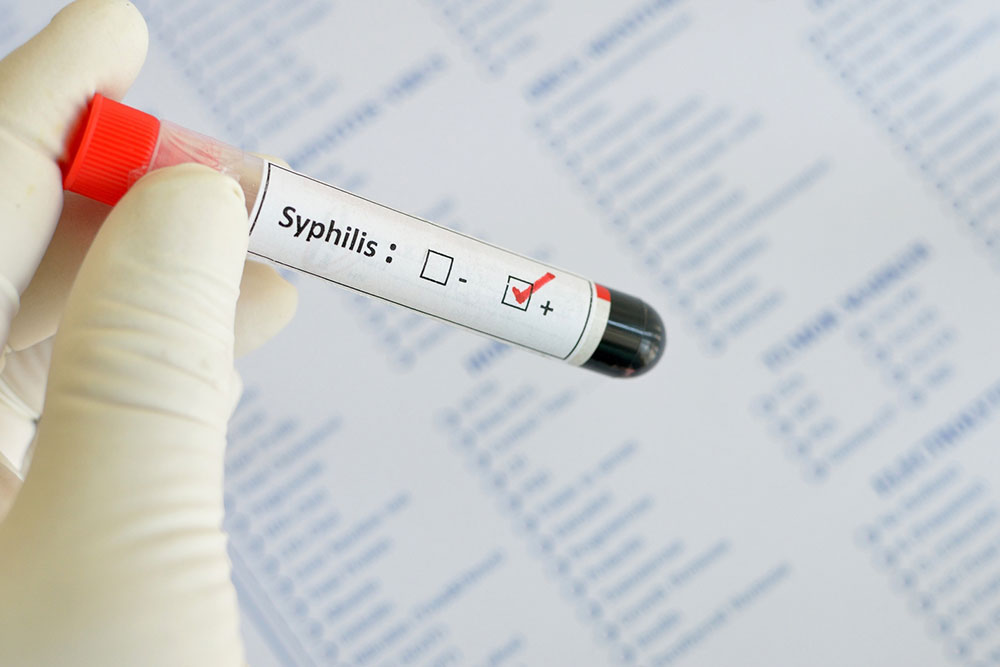Syphilis – Early Signs and Diagnosis
Syphilis is an STI caused by the bacterium Treponema pallidum. Although reported cases of syphilis infection reached a record low in 2000–2001, the incidence has been increasing again. So, understanding how the infection spreads and its signs can help one identify the condition early and manage it better to avoid further health complications. So, here are the signs and symptoms of syphilis at various stages and other key facts about the condition:
Signs
Syphilis develops in three stages—primary, secondary, and tertiary (late stage). Each of these stages is defined by a unique set of symptoms.
Primary (first) stage: This stage begins two to twelve weeks after infection or exposure to someone with syphilis.

Secondary (second) stage: This stage begins a few weeks after the first sore disappears.
– A rough, bumpy (generally non-itchy) rash covering the whole body, especially the palms and the soles of the feet
– Tiredness or fatigue
– Fever
– Headaches
– Wart-like sores
– Muscle aches
– Hair loss
– Swollen lymph nodes
Latent stage: The symptoms may come and go over a few weeks or months. After this, the disease moves into a latent or latency stage, where one does not experience any symptoms despite still being infected by the bacterium. In the first year of this stage, the disease can still be transmitted through intercourse. After a couple of years, although the infection does not go away, it cannot be passed on anymore (except in the womb, i.e., from a mother to unborn child). This latency stage continues for a long period without any symptoms. If left untreated, it moves into the more dangerous tertiary stage of syphilis.
Tertiary stage: This stage begins years or decades after the original syphilis infection. Symptoms during this stage depend on the part of the body the bacterium spreads to. At this stage, symptoms such as stroke, dementia, brain damage, cognitive health problems, loss of coordination, numbness, paralysis, and sensitivity to light could develop. Other symptoms could be loss of vision, loss of hearing, heart disease, nerve damage, seizures, dizziness or vertigo, or skin rashes.
Congenital syphilis
Syphilis can also be passed on to a baby in the womb through the placenta or during birth. Initially, newborns may not display any symptoms of syphilis. Over time, however, the following may emerge:
– Sores and rashes on the skin
– Fever
– Jaundice
– Lack of red blood cells or anemia
– Swollen liver and spleen
– Rhinitis
– Bone changes
Syphilis may also lead to loss of hearing, teeth problems, and a saddle nose. In some cases, syphilis can also cause issues with the umbilical cord, premature birth, and other issues associated with birth.
Diagnosing syphilis
To diagnose this condition, doctors rely on a combination of methods. The process begins with an in-depth conversation, which helps doctors understand the patient’s medical and personal history. That’s why it is important to be open and honest during this conversation, as it plays a key role in determining the risk of syphilis. Based on this discussion, the doctor will prescribe certain treponemal tests for syphilis. These may include TP-PA, various EIAs, chemiluminescence immunoassays, immunoblots, and rapid treponemal assays. If the treponemal test results are positive, the doctor may follow them up with a nontreponemal test with a titer to confirm the diagnosis. This pattern (treponemal, followed by nontreponemal) is known as reverse sequence testing. It helps identify those who were previously treated for syphilis and those with untreated syphilis.
In cases of congenital syphilis, additional testing may be necessary. Doctors may recommend a quantitative nontreponemal test on an infant serum. If the results here are reactive, the baby must be thoroughly evaluated for congenital syphilis by examining suspicious lesions, fluids, or tissues using dark field microscopy, PCR testing, and/or special stains. Other tests, like analysis of cerebrospinal fluid by VDRL, cell count and protein, CBC with differential and platelet count, and long-bone radiographs, may also be required.
Risk factors linked to syphilis
While anyone engaging in intercourse is at risk of syphilis, the risk is comparatively higher for:
– Those engaging in unprotected intercourse
– Those with HIV
– Those who have been intimate with someone who tested positive for syphilis
– Anyone who has tested positive for another STI, such as chlamydia, gonorrhea, or herpes
The condition is more manageable when detected early. So, one should keep an eye out for early syphilis symptoms and seek a diagnosis upon noticing any symptoms.

